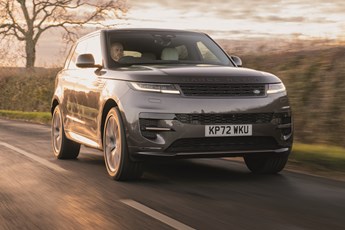Date:
08 February 2023
|
Author: Martyn Collins
Could the new plug-in hybrid version of the Sport be the Range Rover sweet spot for fleet?

|
|
||||||||||||||||||||
We already know how good the new Range Rover launched last Spring is. Its combination of attractive design, impressive refinement and great drive on and off-road saw it walk away with our Driver’s Choice at last year’s Business Car Awards.
But what about its (slightly) smaller and sporty sister car – the all-new Range Rover Sport? Like its big sibling, almost everything is new. It shares the same MLA-Flex architecture, it’s powered by the same engines, but fleet interest is expected to be focused on the petrol plug-in hybrid versions. Either the P440e that we have here, or the even more powerful P510e. Unlike the rest of the range which falls into the 37{da793fdcd3fe679df000853cab620e3a76d4f41f7c86540cc967171bbb315377} BIK band, despite its price, this Range Rover Sport slots into the much more affordable 5{da793fdcd3fe679df000853cab620e3a76d4f41f7c86540cc967171bbb315377} band.
The P440e combines Land Rover’s 3.0-litre straight-six Ingenium petrol with a 105kW electric motor and 38.2kWh battery hidden under the back seat. Starting in full-electric, it’s a refined unit, quietly switching to petrol power as speed builds. Acceleration to 60mph takes 5.5 seconds yet is still capable of covering 70 miles on electric power alone – we saw about 50 miles in the cold winter weather when we drove this car.
Whereas the latest Range Rover is more evolution than revolution, the new Sport is something a bit different. Most like the Range Rover at the front, it has slim headlights and grille, a deep front air dam and registration plate at the bottom. The rear is where the changes for the Sport are more differentiated, with its thin, horizontal rear lights and single clamshell boot. The Range Rover is still better-looking however, in our opinion
Inside, the new Sport looks and feels identical to the Range Rover. So, think the same dashboard with its 13.1in tablet-style ‘Pivi Pro’ navigation system, which dominates the centre console and replaces the outgoing complicated two screen system, with physical ventilation controls. Elsewhere, there’s a three-spoke steering wheel – compared to the Range Rover’s new two-spoked one, but the same seats with various massaging options.
Now the Sport shares the same 2,997mm wheelbase, there’s decent rear legroom. However, the lower roofline gives the Sport’s interior a different, more contemporary feel. Boot space is a practical 780 litres – as the battery doesn’t affect it.
With soft leather and subtle aluminium trim on the SE model that we drove, there’s no doubt the latest Range Rover’s interior feels special. We’re less keen on the dated switchgear and wonder if the curved infotainment screen would look better integrated into the dashboard.
On the road, the new Sport drives much the same as the standard Range Rover – with added dynamism. Even on optional 22in wheels, the ride remains composed and comfortable – this is thanks to clever electronics constantly monitoring the road surface. It is not totally perfect though, as at high speed there’s sometimes an odd fidgety feel.
Then there’s the handling, which considering its 2,735kg weight and tall body lives up to its ‘Sport’ badge. This is because it shares the Range Rover’s clever 48V active roll-control system, which works by turning on or off the anti-roll bars by monitoring road conditions. In fact, with the Sport’s more precise steering, plus the clever rear-steering adding agility and the ‘Dynamic’ driving mode engaged, this Sport is surprisingly involving to drive – even if it is at the expense of some ride comfort. We didn’t get the chance to try it, but understand this Sport is as capable as any Land Rover off-road.
So, in PHEV form, is the Sport the Range Rover of choice for fleet? We’d say yes, as the new tech and features combined with the savings from the drivetrain, make for an attractive, good to drive package, with reasonably affordable running costs.
Range Rover Sport 3.0 440e PHEV SE
P11D: £84,475
Residual value: 61.39{da793fdcd3fe679df000853cab620e3a76d4f41f7c86540cc967171bbb315377}
Depreciation: £32,620
Fuel: £7,822
Service, maintenance and repair: £5,382
Cost per mile: 76.37p
Fuel consumption: 313-353mpg
CO2 (BIK {da793fdcd3fe679df000853cab620e3a76d4f41f7c86540cc967171bbb315377}): 20g/km (5{da793fdcd3fe679df000853cab620e3a76d4f41f7c86540cc967171bbb315377})
BIK 20/40{da793fdcd3fe679df000853cab620e3a76d4f41f7c86540cc967171bbb315377} a month: £70/£140
Luggage capacity: 780 litres
Engine size/power: 2,997cc/440hp
Verdict |
||||
 |
|
 |
|
|
Subscribe
